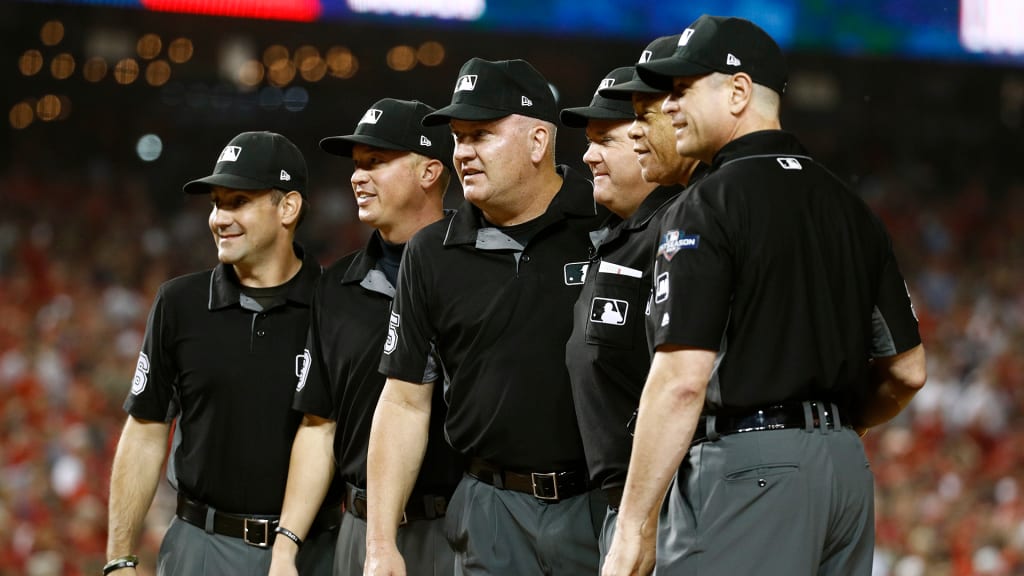
Three teams take the field for every MLB game. Besides the home and away nines, a team of four umpires -- or six during the playoffs -- also want to be at their best on the diamond every day. They have their own locker room. They have their own numbered uniforms. And they impact every game. Unlike the players, however, they don't want to be the center of attention. But they will be in this article as we list seven things you didn't know about Major League umpires.
The crews
While there are more than 700 players on active rosters, there are only 76 full-time umpires in the Majors. Prior to each regular season since 1952, the umpires have been broken into four-person crews, each of which is headed by a crew chief assigned by the Commissioner of baseball.
Each umpiring crew is formally identified by a letter from A through S and has a mixture of veterans and newcomers that contains about 50-70 combined years of MLB experience.
Counting the squats
Every batter gets into their own stance prior to each pitch, and the same goes for the home-plate umpire, who stands tall before crouching down -- or squatting -- behind the catcher as the pitcher begins their delivery. And because everything in baseball finds a way to be quantified, an ump's number of squats during a season has been tracked every year since 2008. The single-season leader in squats is Tim McClelland, who called 11,417 pitches in 2009. According to the MLB umpire media guide, it is proper to say that the umpire who called the most pitches each season won the "squats crown."
Road to The Show
You might be wondering: How do you become a baseball umpire? Here's an overview.
The journey to becoming a Major League umpire begins -- and ends -- for many in Vero Beach, Fla., at the MiLB Umpire Training Academy. Each January, prospective umpires descend upon the academy for a month-long camp where current and former Major and Minor League umpires serve as instructors and administrators.
At the end of the month -- and after many hours of classroom learning, on-field drills and live game exercises -- a small percentage of the students are offered an umpiring position in Minor League Baseball, starting at the Rookie level. Those umpires work for about six to seven years before they have an opportunity to earn Triple-A classification, at which point they will be supervised and evaluated by MLB for either part-time or full-time future assignments.
The boss of the baseballs
MLB umpires have a host of pregame duties, but nothing is more important in baseball than, well, the baseball. And each game's home-plate umpire, who is also known as the umpire-in-chief, is the "sole judge of the fitness of the balls to be used in the game," according to the league's official rulebook.
It is that umpire's job to inspect each of the baseballs supplied by the home team to make sure it meets regulation standards and has been rubbed properly so as to remove any gloss. The umpire must also verify that the home team has enough regulation balls in reserve to replace those that are taken out of play, and they must be in possession of at least two reserve balls at all times during a game.
A peculiar mannerism
Do you ever wonder why when a home-plate umpire flashes the count of a certain at-bat, using their right hand to display strikes and their left hand to display balls? To the pitcher, the fielders and the TV viewers alike, this looks backwards if you're reading from left to right; no one describes a full count as having "two strikes and three balls." But the reason has everything to do with the right hand, which is considered the action hand in baseball
It is taught that the right hand signals strikes in every at-bat. In the early 20th century, Cy Rigler was the first umpire to use his hands to signal strikes and he did so with his right. All out calls are traditionally made with the right hand, and it's the hand used by the home-plate umpire when he points at the starting pitcher while yelling "Play!" to officially begin a game.
Tools of the trade
Few people have probably ever asked an MLB umpire "What are you wearing?" But anyone can look exactly like an official umpire. All of the necessary apparel, from the chest protector, facemask or shin guards by Wilson to the sky blue or black shirts by Majestic, is available online. You can even purchase the official home-plate brush by Franklin.
"Retired" numbers
Each MLB team has its own collection of retired numbers, and so do the umpires. Sort of. The No. 1 of Bill Klem and the No. 3 of Al Barlick are two that were retired by the American and National Leagues. However, that's more of a gesture to recognize their contributions to baseball since those and all other retired numbers are still used by today's MLB umpires.
The only number that is truly unavailable is, of course, No. 42.
